How to Update WordPress: The Essential Guide
Knowing how to update your WordPress site is an important responsibility of being a WordPress website owner or admin. Keeping up with WordPress updates is vital to the security and overall functionality of your website. Fortunately, you've landed on the essential guide for how to update your WordPress site.

Knowing how to update your WordPress site is an important responsibility of being a WordPress website owner or admin. Keeping up with WordPress updates is vital to the security and overall functionality of your website. Fortunately, you’ve landed on the essential guide for how to update your WordPress site.
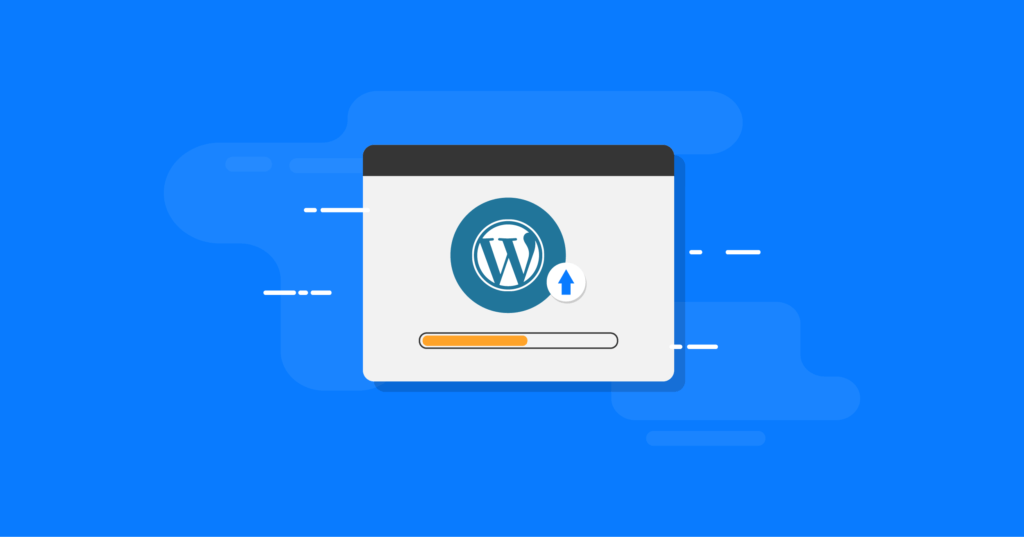
In this guide, we’ll give you all the information and tips that you’ll need, no matter if you’re updating your theme, plugins, or WordPress core. By being informed on when and how to update WordPress, you’ll keep your site secure and running smoothly. Now, let’s take a look at everything you’ll need to know about updating WordPress. Ready to get started? Let’s go.
When a new WordPress update appears on your website, how comfortable are you with running them? Do you avoid running updates for WordPress due to a fear of breaking something on the site?
These updates may seem a little unnerving at first. What happens if you update WordPress? How important is it to pay attention to WordPress updates as they become available? Do you really need to run all the updates that are waiting on your site?
What Are WordPress Updates?
WordPress updates are changes in the WordPress core software that runs WordPress functionality. The term “WordPress updates” applies to WordPress version updates that are made available through your WordPress admin dashboard.
“WordPress updates” can also be applied more broadly to the updates to the themes and plugins you use to run your website. Theme and plugin updates are often released, so you need to be aware that plugins and themes need to be updated as well.
Before we look closer at updating WordPress, let’s unpack a few more details about WordPress updates.
- WordPress updates are sent out on a regular basis by the WordPress core software developers to add new features and enhancements, address issues with security and performance, and more.
- WordPress itself checks for updates automatically to its core functionality, as well as the themes and plugins you’ve installed. You will see current updates highlighted within your dashboard in the Updates page of your WordPress admin dashboard.
Simply stated, an update allows WordPress to inform users when a new WordPress version, theme or plugin is available. It’s strongly recommended that you always keep WordPress fully up-to-date by installing new versions when they become available.
Most new versions and updates will contain vital security patches that protect your site from malicious attacks. By failing to update to new versions as they become available, you’re opening your site up to bigger security risks.
Where to Find WordPress Updates
On the Updates page inside the WordPress dashboard, any administrator user has the ability to upgrade, update or re-install WordPress core as well as run updates on themes and plugins that require them.
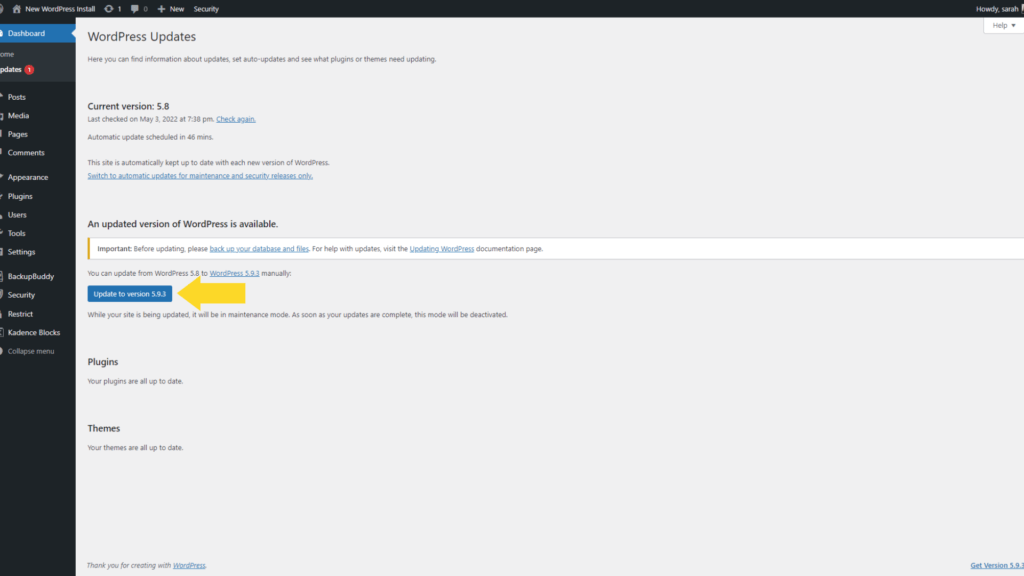
Certain themes and plugins that you’ve downloaded from third-party sites may not show you available updates in your WordPress menu. For these, you’ll need to manually update the themes and plugins by downloading the newest versions from the original download source.
However, pretty much anything that you’ve downloaded from the WordPress.org theme and plugin repository will have the auto-update option already built-in. You’ll see these updates in your WordPress dashboard.
Trusted commercial third-party theme and plugin developers such as Gravity Forms, Restrict Content Pro and iThemes, although not necessarily downloaded from WordPress.org, do have auto-updates within your dashboard built-in to their products. These plugin updates are provided via their own licensing system, so it’s important to license any premium themes or plugins you buy.
Why Should I Update My WordPress Site?
Updating WordPress is very important for a number of reasons including security, reliability and stability of your site, and website speed. WordPress updates also give you access to the latest features and tools.
WordPress updates may seem like an annoyance or inconvenience to run. After all, you already have everything on your site running exactly the way you want. Why upset the chemistry of your site by throwing updates at it, especially when there’s a chance the updates could break things?
There are several reasons why WordPress updates are important.
1. Security
The top reason to keep up with WordPress updates is for site security. WordPress, like any other platform, isn’t 100% secure. Even at this very moment, there is the potential that some themes, plugins and core WordPress files are vulnerable. Just check out any of our recent WordPress vulnerability round-ups.
The updates you get from WordPress combat security threats. They work to fix and repair the latest known hacker attempts to stay a few steps in front of them.
Think of it this way: If you don’t keep your site fully updated, you’re opening your site up to being hacked. In fact, running outdated versions of WordPress core, WordPress themes and WordPress plugins is the #1 reason WordPress websites get hacked. By learning the proper way to keep your site updated, you’ll reduce the odds of successful hacking attempts.
A WordPress security plugin like iThemes Security Pro can work to fix common WordPress security holes and add extra layers of security to your website, but a plugin can only do so much if you’re running a vulnerable version of WordPress. That’s why staying updated is so important.
2. Reliability and Stability of Your Site
Nearly every update you run will have a set of bug fixes. These updates will attempt to improve on any issues contained in previously released versions.
While it’s true that some new updates could introduce issues to your site, running updates will help make your site more stable and won’t cause any major issues.
3. Website Speed
Not every new update to WordPress will bring a noticeable impact to the speed of your site. However, many updates contain optimizations and fixes that help your site run faster and smoother. These changes often increase the performance of your site or blog by reducing the resources that a resource-heavy feature uses.
Other times, an update can be much more significant. And these updates may extend beyond WordPress itself. For example, when the 7.3 version of PHP was released, it contained support for some of the newest internet technologies. This made it substantially faster than the previous versions. It also caused many users to see a WordPress PHP Update Required error message in their WordPress admin dashboard.
4. New Tools and Features
Downloading the latest WordPress updates can also bring new tools and features to your fingertips, helping you take on day-to-day tasks more efficiently.
For example, with the release of WordPress 5.0, WordPress core was updated and the Classical editor was replaced with the Gutenberg WordPress block editor, a more user-friendly way of producing content. WordPress 5.5 brought even more features and improvements, including WordPress block patterns and WordPress reusable blocks.
As the Gutenberg WordPress block editor continues to evolve, it’s important to stay on top of WordPress updates. This ensures you have access to the most improved versions as they’re released.
Before You Update WordPress: Backup Your Website
As you probably know, backing up your WordPress website is something that needs to be done on a regular basis. This is especially true when you’re making structural changes to your site, like changing the theme, installing untested plugins, and/or editing the core code of your blog.
It’s equally important to backup your site when you update it to a new version of WordPress. After all, there’s always a chance that the new updates could break your site.
Because every WordPress site is customized differently by its administrators, updates in WordPress can impact different sites in different ways.
How Do I Update My WordPress Site?
Even if this is your very first time looking into how to update WordPress, the process is easier than you probably think.
There are three main ways that you can approach updates. Let’s take a look at each method.
1. How to Update WordPress Core Within the WordPress Admin Dashboard
This is the simplest way to get your WordPress system updated, and it’s just a click away.
- Login to your dashboard to check to see if there’s a notification for an update at the top of your page.
- If there is, click on “Update Now” to start the process. This will take you to your Updates page where you’ll need to click on an “Update Now” button for a second time.

For minor core updates, you will see a success message, as well as options to update your theme and plugins, if available.
If, on the other hand, the update is a major release like this one from WordPress 5.9, you’ll be taken to a welcome screen that details everything that’s been upgraded within WordPress.
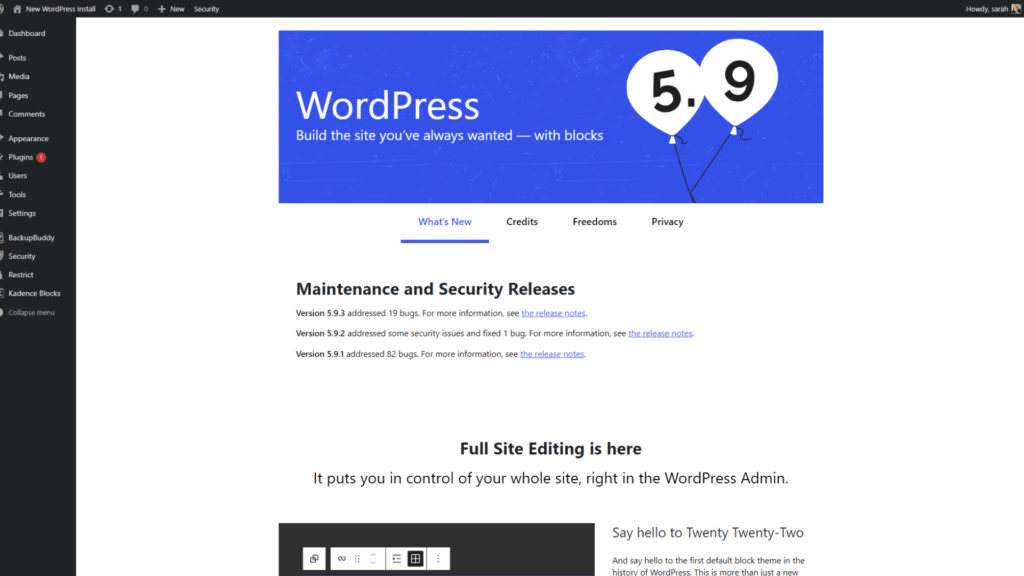
You may then proceed to update themes and plugins to ensure that they’re fully compatible with the new version of WordPress.
2. How to Update WordPress Using sFTP
If there’s ever a reason that you’re not able to update WordPress from your admin dashboard, you can also run the update manually.
To utilize this method, use either an FTP/sFTP client (FileZilla is a great option), or your File Manager within the control panel of your hosting account. For either option, you’ll be accessing the root directory of your WordPress site.
To update your WordPress site manually, you’ll need to overwrite old core files (wp-includes and wp-admin) with new files.
Here’s how to manually update WordPress using an FTP client, such as FileZilla:
1. Download the current version of WordPress core. Unzip the downloaded files.
2. Access your extracted folder. Delete the wp-content folder and the wp-config-sample.php file. This will help you avoid losing vital data in the update process.
3. Connect to your WordPress site with the FileZilla client (or a different FTP client if you prefer) and log in.
4. Locate the current web host wp-includes and wp-admin directories. They’re located on the right of the panel, then delete them by right-clicking.
5. On the left of the FileZilla panel, select your new wp-includes and wp-admin folders and upload them.
6. When this is complete, upload the remaining unzipped WordPress files from your workstation to the web host’s directory. When you upload the new files to the server, they will overwrite the old WordPress files.
7. When you see the confirmation stating “Target file already exists,” check on the “Always use this action” option and “Apply to the current queue only.”
8. After all of the files are successfully uploaded, head to yourwebsite.com/wp-admin/upgrade.php/ to verify that the new WordPress version has been successfully added to your site.
3. Automatic WordPress Updates
When minor updates are released, WordPress will automatically update in most cases. However, it’s also possible to set major releases, not just the minor releases, to update automatically.
One way to do this is by downloading and installing a plugin like Easy Updates Manager. This plugin will allow you to set customizable auto-updates based on a criteria you set.
Another way to enable automatic updates on major releases is by adding a short line of code to the wp-config.php file.
To do so:
1. In your host’s control panel, find the File Manager (located under the Files section).
2. Open the public_html folder and scroll down. Select the file that says wp-config.php.
3. Click on the Edit button that’s in the menu on top.
4. Change (or add) the following line of code:
define('WP_AUTO_UPDATE_CORE', true);
5. Save when you’re done.
That’s all there is to it.
If you’re not comfortable working with the code of your site, now is a great time for a WordPress training class that will give you the confidence you need to dig into the inner workings of your WordPress site.
When Should I Update My WordPress Site?
The short answer is: it depends. There are different approaches to when exactly to update WordPress and, as such, different answers to the question.
Some WordPress developers like to run updates right away for the purpose of website security. Many will even run the updates without testing and hope for the best (not at all recommended, but more common than we’d like to think).
Seasoned developers take the time to test updates within a dedicated testing environment before introducing them to any live site. This is an important (and highly recommended) step because you’ll get to see how the updates impact your site before sending them live.
Another approach to running updates is first to wait a few days and see if the rest of the WordPress community suffers any issues with the new update. If several days have passed since a new release and no issues are reported, it’s probably safe to run the update on your site.
How to Update WordPress Plugins
If your site has any required plugin updates, you’ll see the individual plugin update notifications within the WordPress dashboard. You’ll notice two arrows forming a circle on your top toolbar, with a number that indicates how many updates need to be run.
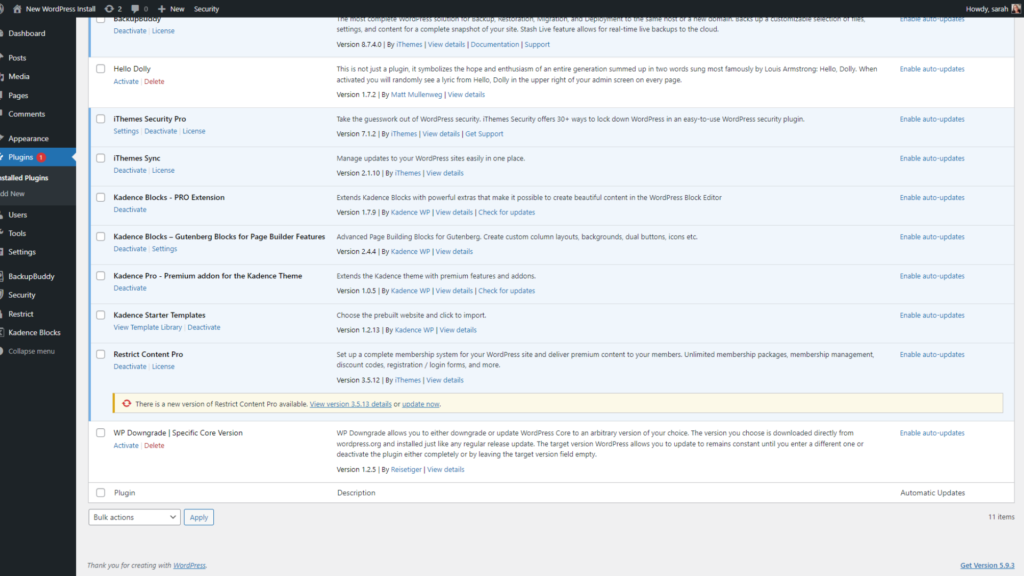
Click on the icon and you’ll be taken to a page that shows a full list of plugins that require updates (if any currently exist). Here, simply click on “Select All” and then “Update Plugins.”
When you do this, WordPress will start downloading all update files for each plugin requiring an update. After downloading, WordPress will apply the files to each plugin accordingly.
After this process completes, head to the live version of your site and make sure everything’s running correctly and without errors. If all is well, click again on the update icon on your top toolbar. You’ll notice that the number shown next to the icon has decreased by the number of plugins that were updated.
How to Update WordPress Themes
On occasion, the theme you’re using on your site will need to be updated. To do this, head back to your updates page in WordPress and scroll down to the dedicated section for themes.
Click on the box that’s next to the theme you’re updating, then click “Update Themes.” This process will run similarly to plugin updates.
Once this process completes, again you’ll want to check your site to make sure the update didn’t cause any unexpected issues. If it does, you can roll your backup version out and go back to how your site appeared prior to running the update.
If there were issues with the theme update, get in touch with the theme developer and let them know of the specific errors that happened on your site when you ran the update. They’ll be able to give you direction on what steps you should take to resolve the issue.
Should You Update WordPress Core or Plugins and Themes First?
There’s no perfect order to run updates that will guarantee nothing will break on your site. However, if you want to make the risk as minimal as possible, download updates to WordPress core first, followed by plugins and themes.
The reason this helps minimize risk to your site is because when developers release updates to plugins and themes, they’re typically designed around the most current WordPress version.
By installing the most current WordPress version first, the plugin and theme updates you run later should be compatible with it.
When you install updates in the opposite order, the updates made to your plugins and themes may not work well with the older version of WordPress you’re running. The new versions of plugins and themes have likely been tested on the most recent WordPress version and could cause unwanted conflicts on an older version.
Troubleshooting WordPress Version Updates
Major updates of WordPress are more likely to cause bad things to happen to your site than minor updates. But that doesn’t mean that you should avoid running them.
These major updates to WordPress are often very important to the security of your site and should be run as soon as possible.
Whenever you see a major update come through, make sure to have a backup version of your site that can restore it to the current version if something goes wrong.
Verify That Everything’s Working, Then Backup Again
If you’ve reached this stage in your WordPress update education, congratulations; you’re now a pro at keeping your site up-to-date, safe and reliable. But before you go any further, take a few minutes to give your site one more once-over to make sure everything is in perfect working order.
In addition, clear any caching plugins you’re running so that all of your changes get applied.
If everything’s in perfect working order after all updates have been applied, it’s time to backup your entire site once again. After all, if you were to make a change to your site tomorrow that broke it in some way, you wouldn’t want to lose all the work you’re doing today.
Go save a backup version of your site now, before you forget.
How to Save Time Updating WordPress if You Manage Multiple WordPress Websites
A tool like iThemes Sync can help save time and headaches if you manage multiple WordPress sites. iThemes Sync is designed to help you manage and maintain all your WordPress websites from one central dashboard. Instead of logging in to multiple websites, you have one place to perform WordPress admin tasks.
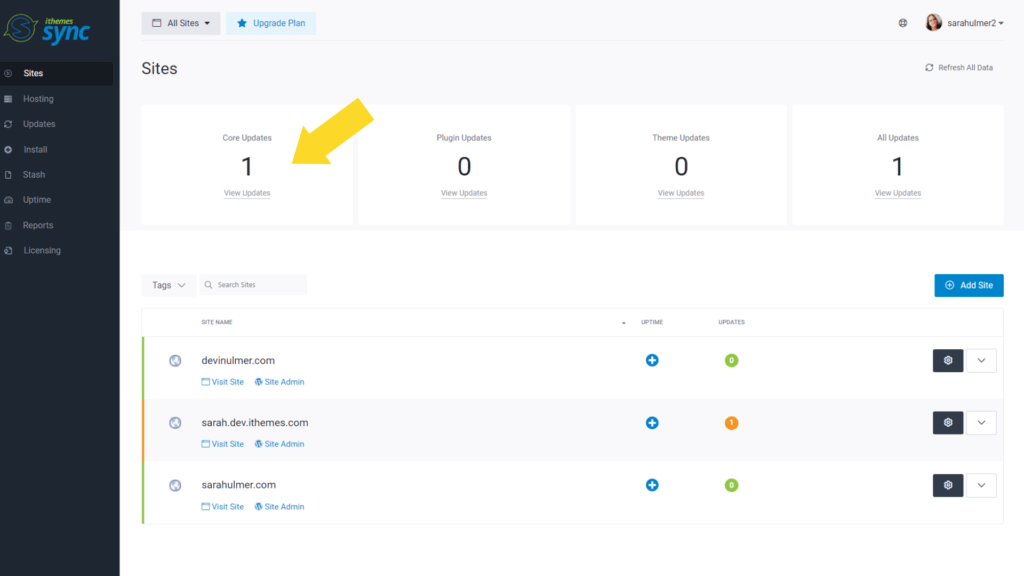
From the iThemes Sync dashboard, you can view a list of available updates for WordPress core, plugins and themes and update with one click. You can also get a quick overview of the number of available updates, run individual updates and view plugin changelogs.
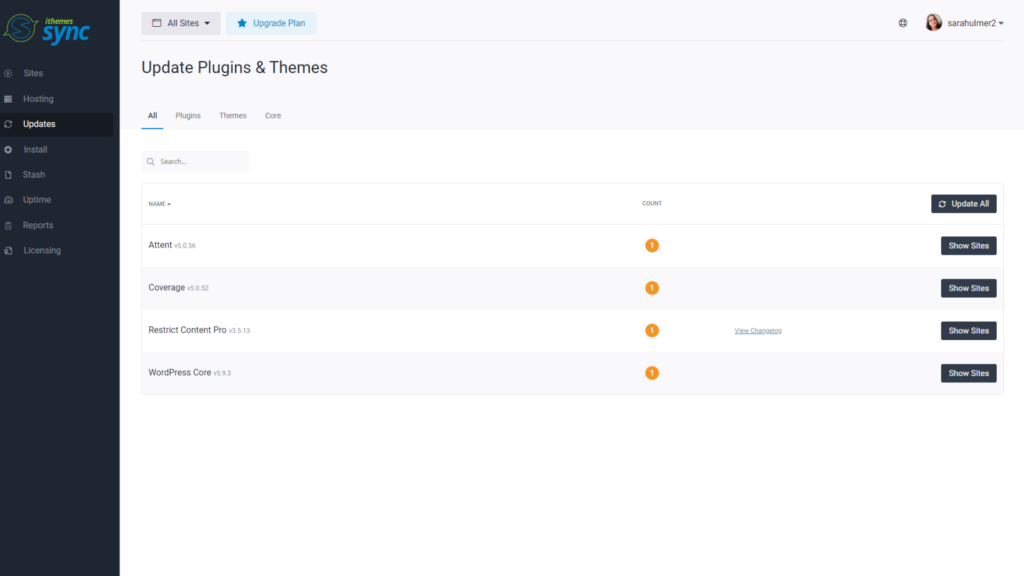
WordPress Version Management
As we mentioned before, keeping software updated is an essential part of any security strategy. WordPress updates aren’t just for bug fixes and new features. Updates can also include critical security patches. Without that patch, you are leaving your website vulnerable to attack.
The Version Management feature in the iThemes Security Pro plugin allows you to auto-update WordPress core, plugins, and themes. Beyond that, Version Management also has options to harden your website when you are running outdated software and scan for old websites.
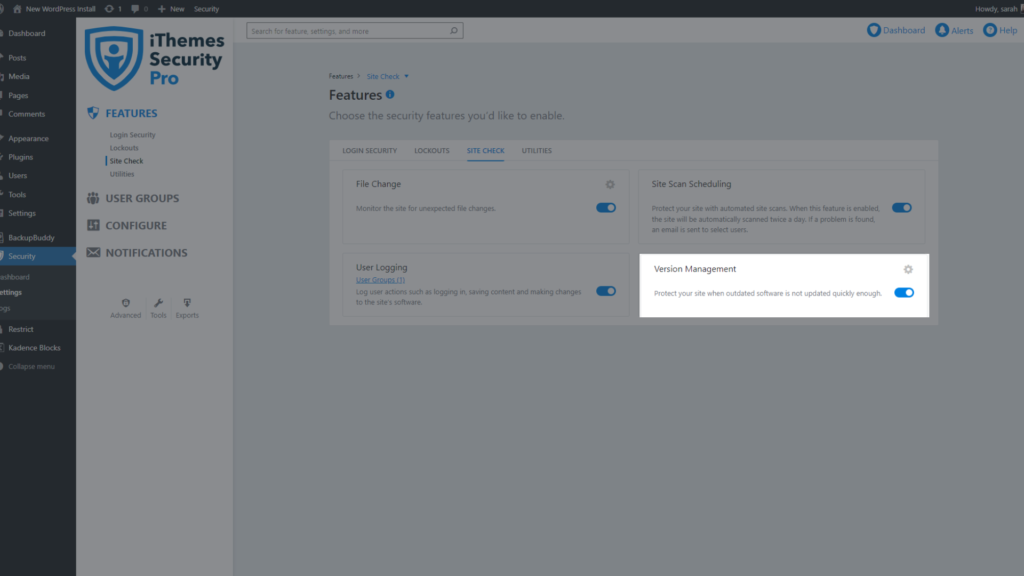
Once Version Management is enabled, you can then tweak the settings, including the ability to:
- Streamline plugin and theme management – manage all of your plugin and theme updates from the version management settings.
- Add custom delay periods for plugin and theme updates – WordPress auto-updates only offer the option to apply updates immediately. The update scheduler allows you to create a custom delay. Delaying can be a good option for plugins or themes that tend to need some follow up releases to fix issues after a major release.
- Only Apply Updates that Fix Known Vulnerabilities – only apply updates that fix known vulnerabilities. This option is perfect if you like to manually run all of your updates but want to receive security patches immediately.
The version management update scheduler has options to disable auto-updates, update immediately, or delay updates for as long as you like. Plus, you can configure both plugin and theme update schedules in the version management settings.
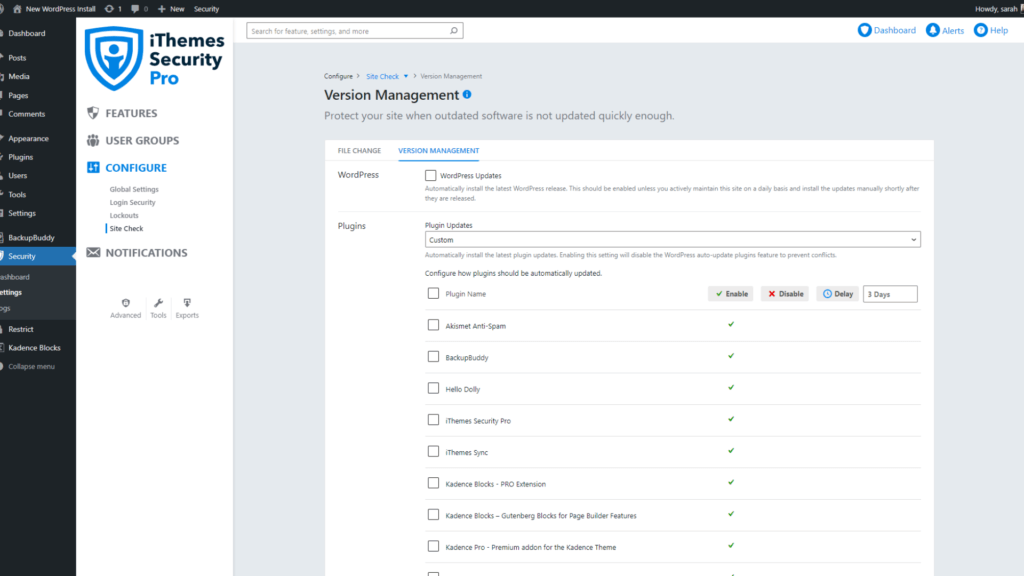
Wrapping Up: How to Update WordPress
Keeping up with updates in WordPress is an important part of your WordPress website maintenance routine. This is especially true if site speed, security, stability, and using new tools and features is important to you.
Don’t allow yourself to get too worried about breaking things when you run updates. After all, if you’re using a plugin like BackupBuddy to backup your site, there’s really nothing to worry about.
If site security is highly important to you (and we hope that it is), a WordPress security plugin like iThemes Security Pro can help further solidify your detail.
For those that manage multiple WordPress sites, iThemes Sync is a must-have tool that will streamline your day by eliminating repetitive work. It’s worth checking into.
By following this guide, you’ll now be able to confidently take on updates when they’re presented to you in the WordPress platform. You’ll also avoid so many of the common mistakes that other people make when updating their sites.
Best of all, you’ll minimize risk to your site and end up running a more powerful and secure website.
Get SolidWP tips direct in your inbox
Sign up
Get started with confidence — risk free, guaranteed
Sign up now — Get SolidWP updates and valuable content straight to your inbox
Sign up
Get started with confidence — risk free, guaranteed